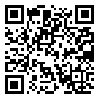Volume 5, Issue 3 (Autumn 2018 2017)
JRIA 2017, 5(3): 49-65 |
Back to browse issues page
Download citation:
BibTeX | RIS | EndNote | Medlars | ProCite | Reference Manager | RefWorks
Send citation to:



BibTeX | RIS | EndNote | Medlars | ProCite | Reference Manager | RefWorks
Send citation to:
Ghasemi Sichani M, Ghanbari Sheikhshabani F, Ghanbari Sheikhshabani M. (2017). Content analysis of Quranic inscriptions on Jameh Mosque of Isfahan entrances and sanctuaries. JRIA. 5(3), 49-65.
URL: http://jria.iust.ac.ir/article-1-831-en.html
URL: http://jria.iust.ac.ir/article-1-831-en.html
1- Isfahan (Khorasgan) Branch, Islamic Azad University
Abstract: (7140 Views)
Quranic inscriptions are the inseparable elements of mosque ornaments, promoting the Islamic culture and reflecting the socio-political conditions of the given era. Due to its importance and vastness together with several structural periods and the volume of decorations, Jameh Mosque of Isfahan is one of the structures containing most of the historical religious inscriptions related to Iranian Islamic architecture. These inscriptions date back to Saljughi, Ilkhanid, Mozafari, Teymouri, Safavid, Ghajar and most recent eras and are embedded on the entrances, court-yard facades, verandas, minarets, bedchambers, domes, sanctuaries, stone troughs, candlestick, tribunes, etc. of the mosque. Most of these inscriptions are exposed through the entrances, internal facades of verandas in (southern, western, east and northern Omar Iwan), the main yard facade, minarets, sanctuaries and domes. These inscriptions may be assessed according to criteria of technique, construction date, content, position, benefactors, restoration manner, their contribution to the architectural space, etc. There exist few studies where the content analysis of these inscriptions embedded in these structures are addressed and assessed; consequently, attempt is made in this article to recognize, analyze and compare the content of Quranic inscriptions on entrances (mosque emblem) and sanctuaries (symbol of Qiblah) of Jameh Mosque of Isfahan. To extract the content of the inscribed verses and assess the thematic correlations as to their political and social terms together with the assigned locations in these structures, this article follows a descriptive-analytical method where documented sources are applied and insitu observations are made. The findings here reveal that the entrances and sanctuaries of Jameh Mosque of Isfahan contain many inscriptions with various contents. The content of these inscriptions consists of: digits (date of construction), personal names (benefactors, rulers, art masters and calligraphers) and hadiths (holy names and Quranic verses). Among 10 entrances and 17 sanctuaries of this mosque, 7 entrances and 8 sanctuaries contain Quranic inscribed Surah: Al-Baqara with three repetitions, Al-Fatiha, twice, Nesa, Al-Ikhlas, Al-Insan, Tobah, Anbia, Ahzab, Jen, Maedeh, Jamah, Al-Emran, Kahf, Noor and Sad Surah with one repetitions. Most of these Quranic inscriptions in this mosque are embedded in Safavid era followed by Ghajar, Al Mozafar, Ilkhanid and Saljoughi eras: Safavid with 9 Surah and 15 Verses is ranked the first, while Saljoughi with one Verse and one Surah is ranked the last. Since the beginning of Iran becoming an Islamic nation, during time, the city of Isfahan has been exposed to severe religious quarrels until Safavid era when Shiism religion sector gained official announcement in Iran. Back then, the city of Isfahan was the major center of Sunni sector. It seems that the selection of verses for inscriptions was influenced by the socio-political conditions of the given era. This fact indicates that during political and social turmoil and unrests between religion sectors the selected Quranic verses are indicative of the specific events, while during relatively political and social proportional calm, the content of the selected verses reflect unity of God, faith and belief in resurrection, prophecy and conveyance of the Prophet and verses about the importance of the mosque. The content of the verses in sanctuaries indicates the events related to the Muslim community like changing Ghiblah, conveyance of the Prophet and leadership. In Saljoughi era, the disputes between Saljoughi dynasty and scholars in Isfahan lead to setting Jameh mosque to arson and it seems that inscribing the 114th verse of Al-Baqarah Surah reveals this phenomenon. In Ilkhanid era, considering the religious disputes, it can be deduced that the benefactors of Aljayto sanctuary by inscribing Quranic and hadith texts with a content specific to Shiism had no other objective than promoting Shiism in Isfahan. The existing military conflicts in Al Mozafar era were influential on the sanctuary inscriptions of Mozafari School and stimulating believers to commit Jihad. By establishment of relative calm in Safavid and Ghajar eras and the orientations towards Shiism thereof, the benefactors selected verses indicating the praise of the prophet of Islam, the status of Amir Al Muminin (the leader of the faithful in Shiism) and manner of meeting God.
Type of Study: Research |
Subject:
Subject- oriented researches in Islamic architecture and urbanism, eg. Spatial-geometrical ideas, symbols and ornaments
Received: 2018/01/21 | Accepted: 2018/01/21 | Published: 2018/01/21
Received: 2018/01/21 | Accepted: 2018/01/21 | Published: 2018/01/21
| Rights and permissions | |
 |
This work is licensed under a Creative Commons Attribution-NonCommercial 4.0 International License. |





